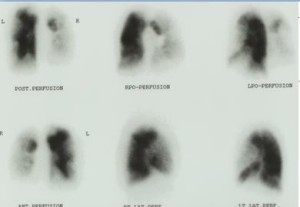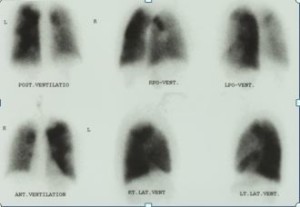Ventilation perfusion scanning used during evaluation for pulmonary hypertension

The ventilation perfusion scan or VQ scan is used to evaluate for the presence of blood clots in the lungs. VQ scanning is very important for several reasons, one being that it can help identify chronic thromboembolic pulmonary hypertension or CTEPH, a disease caused by blood clots, which is the only potentially curable form of pulmonary hypertension. It is also important as it can identify smaller blood clots that may not be causing pulmonary hypertension but that could cause problems such as strokes down the road if not treated appropriately. Blood thinners are used to treat blood clots in the lungs otherwise known as pulmonary emboli. Certain findings are also characteristic of pulmonary hypertension.
What is a ventilation perfusion scan?

The VQ or ventilation perfusion scan is usually performed in a hospital as an outpatient and involves breathing in a radioactive gas and injecting a radioactive substance into the blood via an IV. The radioactive agents are given at separate times and pictures are taken before administering the next agent. The gas fills the airways of the lungs and the substance in the blood circulates through the blood vessels of the lungs. The test then compares the blood flow traveling through the vessels of the lungs to the airflow through the airways of the lungs. Pulmonary hypertension patients usually have near normal airflow where blood flow has been compromised by diseased pulmonary vessels. If there is normal airflow and decreased blood flow, there is a high probability of pulmonary embolisms or blood clots in the lungs.
Each patient should check in with the center performing the test to see if there is preparation that needs to be done prior. As always, it is important to have a follow up appointment scheduled with the physician that ordered the test to go over the results. After discussing the results with the physician the patient should know if there were any indications that they may have blood clots in their lungs and if so what will the treatment plan be. Further testing such as right heart catheterization may be ordered as the VQ scan can suggest but not officially make a diagnosis of pulmonary arterial hypertension.
